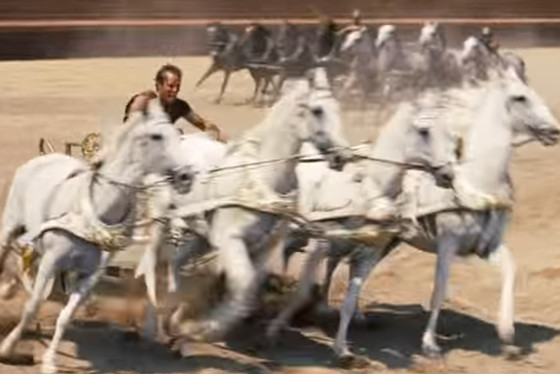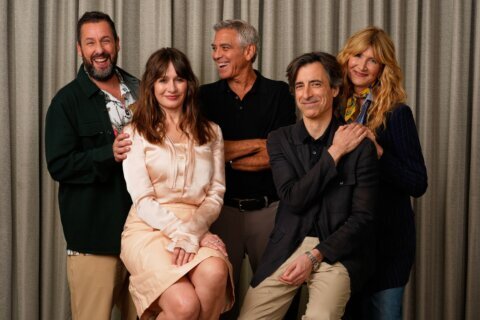WASHINGTON — Swing low sweet chariot? Or go west young man? Get ready for a box office battle that’s a summer cinema showdown of Heaven & Hell.
In the heavenly corner, we have a remake of an iconic Biblical epic about a slave’s divine redemption.
In the hellacious corner, we have a modern western about doomed criminals hellbent on revenge.
The preferred victor in such a moral clash is obvious — forgiveness trumps revenge in a fight for our better angels — but which film boasts the stronger storytelling and more impressive filmmaking?
Time to review “Ben-Hur” and “Hell or High Water.”
‘Ben-Hur’
Before we dive into examining the 2016 remake, let’s start by asking everyone to climb off their anti-remake soapboxes ready to shout: “How dare they remake ‘Ben-Hur!'” Yes, Hollywood is way too obsessed with reboots, but such critiques are ignorant in this case, as the beloved 1959 classic was itself a remake of earlier silent films “Ben-Hur” (1907) and “Ben-Hur: A Tale of the Christ” (1925).
Audiences have seen multiple adaptations of Lew Wallace’s 1880 best-selling novel, which outsold “Uncle Tom’s Cabin” (1852). But the definitive take remains the 1959 adaptation by screenwriter Karl Tunberg with uncredited contributions by Gore Vidal, Christopher Fry and Maxwell Anderson.
The sweeping epic was the crowning achievement of director William Wyler, who won his third Best Director Oscar after “Mrs. Miniver” (1942) and “The Best Years of Our Lives” (1946), not to mention “Wuthering Heights” (1939), “Roman Holiday” (1953) and “Funny Girl” (1968). In total, “Ben-Hur” won 11 Oscars, a record matched only by “Titanic” (1997) and “LOTR: Return of the King” (2003).
To this day, it remains one of the AFI’s Top 100 Movies, though it has sadly fallen to No. 100. This is a travesty of Biblical proportions, likely perpetuated by agnostic film critics who underrate Christ tales that aren’t “The Gospel According to St. Matthew” (1964). “Ben-Hur” is great storytelling. Period.
Which brings us to 2016 and a familiar plot. Jewish Prince Judah Ben-Hur (Jack Huston) has a falling out with his adopted brother Messala (Toby Kebbell), a Roman officer cracking down on Zealots. Suspecting him of treason, Messala imprisons Judah to work as a slave on a Roman galley. But when a navy battle destroys the ship, Judah breaks free and meets a horse gambler (Morgan Freeman), who trains Judah to compete against Messala in a chariot race for a symbolic blow to the Roman Empire.
In a nod to Hollywood lineage, the title role goes to Jack Huston, the grandson of John Huston, who directed and starred in “The Bible: In the Beginning …” (1966). While he’s a rising screen presence with piercing eyes and chiseled cheek bones, he lacks the aura of Charlton Heston, who was fresh off Moses in “The Ten Commandments” (1956) when he won his sole career Oscar in “Ben-Hur.”
It’s a similar bit of historical meta-casting to make the antagonist Toby Kebbell, who voiced the sadistic villain Koba in “Dawn of the Planet of the Apes” (2014) — a franchise founded by Heston. But just like Huston, Kebbell’s performance elicits a similar underwhelming feeling. When you leave the theater, there’s no way you’ll consider his Messala worthy of a Golden Globe nod like Stephen Boyd.
This is less the fault in our stars than it is the mediocre movie around them.
Directed by Timur Bekmambetov (“Abraham Lincoln: Vampire Hunter”), the 2016 “Ben-Hur” is often a darkly-lit vampire of a film. It lacks the Technicolor majesty of the 1950s sword-and-sandal epics, in which painterly palettes fit the larger-than-life, mythical subject matter. These days, our Biblical epics boast a dreary, bluish tint, from Darren Aronofsky’s “Noah” (2014) to Ridley Scott’s “Exodus: Gods and Kings” (2014). I know these were dark times, but the drabness is getting to be draining.
On the bright side, Bekmambetov deserves major kudos for his triumphant action sequences. The sinking of the galley ship is a welcome update to the dated sea battle of 1959, while the chariot race absolutely lives up to the historic hype. As horses gallop over a ground-level camera — trampling the audience — we are reminded of John Ford’s “Stagecoach” (1939). Best of all is a rapid tracking shot across the ground that hits a dead body and flips, the footage continuing to roll upside down. Wow!
While these set pieces rival the 1959 classic, the 2016 script is in too much of a hurry getting to these big moments. Co-written by exodus experts John Ridley (“12 Years a Slave”) and Keith Clarke (“The Way Back”), the three-and-a-half-hour redemption story is sadly crammed into two hours.
Sure, modern audiences have shorter attention spans, but the pacing sacrifices the scope and wonder, leaving subplots unexplored (Arrius’ adoption of Judah), sequences underdeveloped (the leper colony is made confusing) and subtext ignored (the homoerotic subtext added by Vidal).
I suppose such changes are forgivable for the sake of time, as are minor amendments like the cause of Judah’s arrest for treason. This catalyst is changed so that it’s no longer an accidental falling piece of the roof that strikes the Roman officer below. We understand why the 2016 filmmakers would choose a more violent option, but there was something beautifully ironic that a literal crumbling piece of the Roman Empire would spark the eventual figurative crumbling of that same empire.
Either way, there’s no forgiving the cardinal sin of changing a major plot point like Messala’s fate.
SPOILER ALERT: While Messala is killed during the chariot race in the 1959 movie, he survives the chariot race in the 2016 film. While his chariot race survival is more in line with the novel, the book sees him recover from his injuries to plot Judah’s murder, only to then be killed by his mistress.
The 2016 film conveniently allows Messala to survive, but changes his ultimate demise by allowing him and Judah to hug it out. To compare it to another classic that people forget was a remake, “The Wizard of Oz” (1939), it would be like Dorothy deciding not to melt The Wicked Witch, then skipping down the Yellow Brick Road together singing a rousing rendition of “Ding Dong a New Best Friend.”
No joke, this is the corny feeling we’re left with in the heavy-handed finale. Not only do we get hand-holding narration by Morgan Freeman (show us, don’t tell us), we get a cheesy song choice and a final cop-out image of reconciliation like an episode of “Touched By an Angel.” Forgiveness is divine, but ya gotta earn it. It’s no surprise the film is co-produced by Roma Downey and husband Mark Burnett.
Forgive them, Father of Filmmaking, for they know not what they do.
Then again, let he without sin cast the first stone. I humbly digress.
The point is that a master filmmaker like Wyler understood nuance, creating a larger-than-life Christ by never showing His face or hearing Him speak. After the opening Nativity, Wyler introduces Jesus as a carpenter with back turned, entering the frame to give Judah water. Later, when Judah repays the favor, we don’t see Jesus’ face, only His crown of thorns. At the Sermon on the Mount, we see Him only from a distance, while the Crucifixion uses an emotionally devastating reverse angle.
In the 2016 version, we see Jesus’ face constantly and hear His famous words, which feel forced as casual dialogue. Rather than Judah overhearing the commotion of Jesus’ cross-carrying walk, the reboot cuts away from Judah’s story to show us Jesus’ arrest in the garden, followed by close-ups of His final moments on the cross. As a filmmaker, you should pick a path: either go all-in on Jesus’ story (showing His miracles in parallel action throughout Judah’s story), or stick with Judah having chance Christ encounters. To suddenly switch perspective in the final 15 minutes is jarring.
Wyler earned his finale as Heston said, “I felt His voice take the sword out of my hand,” Miklós Rózsa’s music swelled, and a symbolic shepherd led his flock with the crosses of cavalry in the distance. For true believers, it’s one of the great goosebump moments in cinema. That’s sticking the landing.
To use a Rio Olympics analogy — which has been bombarded by flashy “Ben-Hur” trailers — the 2016 film is an amazing balance-beam routine (the chariot race) where the gymnast doesn’t stick the landing (the cheesy cop-out finish). You see the potential for high marks by the judges, or in this case movie critics, but when the filmmaker doesn’t stick the landing, out come the point deductions.
And so, the new “Ben-Hur” isn’t some “how dare they” reboot. It exceeds our low expectations on many fronts, namely the action, but falls short of a true titan of film history. If you’re the sad, stingy sort who rolls your eyes even at the 1959 epic, you either haven’t seen it lately or you aren’t looking closely enough. Wyler was a genius. To put it in his terms, the new “Ben-Hur” isn’t one of the best films of our lives; it’s more like a summer Roman holiday before the real Oscar chariot race begins.
The 1959 classic “Ben-Hur” is playing at the AFI Silver Theatre on Saturday, Aug. 27. Click here for more.

‘Hell or High Water’
For those tired of summer and itching for the Oscar chariot race, check out “Hell or High Water.”
It’s a must-see for anyone who loved the Coen Brothers’ modern crime western “No Country for Old Men” (2007), a slight notch below that Best Picture winner, but a worthy successor to its legacy.
Set in contemporary West Texas, the film follows divorced father Toby Howard (Chris Pine) and his ex-con brother Tanner (Ben Foster), who hatch a scheme to save the family farm in post-recession America. Robbing multiple branches of the bank that’s about to foreclose on their ranch, the duo is hunted by aging lawman Marcus Hamilton (Jeff Bridges) in his final case before retirement.
The entire exercise would not have worked if not for the spot-on casting of the polar-opposite brothers. Chris Pine (“Star Trek”) shines as the thoughtful, reasonable, quiet type, while Ben Foster (“Lone Survivor”) steals the show as the trigger-happy hothead seeking earthly pleasures.
Jeff Bridges makes the perfect gruff ranger to fill the spur-clanking boots retired by Tommy Lee Jones in “No Country.” Bridges seems to pull from his Rooster Cogburn in the Coens’ “True Grit” (2010). Or, maybe his Uncle Sam lawman is the natural progression of a career spent studying Sam the Lion in “The Last Picture Show” (1971) and Sam Elliott in “The Big Lebowski” (1999).
As Elliott’s Stranger said, “Sometimes there’s a man. I won’t say a hero, ’cause what’s a hero?” As Timothy Bottoms said in “Last Picture Show:” “Nothin’s really been right since Sam the Lion died.”
Which brings us to the single greatest character in “Hell or High Water” — the West Texas setting. Cinematographer Giles Nuttgens, who shot Deepa Mehta’s “Elements Trilogy” (1996-2005), works with director David Mackenzie (“Starred Up”) to capture some gorgeous compositions, blending the region’s natural beauty with its decaying man-made structures. You can freeze any shot and frame it.
It’s a sprawling desert canvas of oil rigs pumping in time with the high blood pressure of 20th-century folks trying desperately to survive in the global corporatism of the 21st century. This anxiety is the timely theme explored by screenwriter Taylor Sheridan (“Sicario”), who pens many a poignant convo between Bridges and his Native American police partner Alberto Parker (Gil Birmingham).
We laugh out loud when a quirky small-town, mean-cuss waitress saunters up to their table and asks, “What don’t you want?” We shed a tear when Alberto says his Native American people had their land taken away by the white man, and now the white man is having its land stolen by bankers.
Just as “Bonnie & Clyde” (1967) captured the imaginations of post-Depression America, “Hell or High Water” is a populist post-Recession parable of Main Street sticking it to Wall Street. If you want to know why Donald Trump and Bernie Sanders captured the populist zeitgeist in 2016, the writing is on the wall during this film’s circular opening shot: “Three tours in Iraq but no bailout for people like us.”
Mackenzie mines this clash of civilizations by cleverly juxtaposing the old world and the new. At a gas station, an old man climbs up onto a horse while young punks pull up in neon green car. During a bank robbery, the high-tech security cameras don’t calibrate with the outdated VHS recorders.
All these combustible elements are bound to blow, building to a thrilling mountain shootout that recalls Bogart at the end of “High Sierra” (1941). After the dust settles, the film’s final porch scene brings a clever exchange of false assumptions and thinly-veiled threats before the camera plunges down under the grass like “Blue Velvet” (1986), signifying the very “Hell or High Water” of its title.

The above ratings are base on a 4-star scale. See where these flicks rank in our Fraley Film Guide, a running list of each year’s movies arranged by echelons of filmmaking quality.








